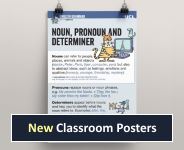Discourse structure
Speakers and writers often use a range of structures and devices to signpost their arguments. These signposts link what they are saying to what they have said before, and to what they are going to say.
Discourse structure is a term used to describe the way in which an entire text is organised – for example, how language is used in a poem, in a newspaper article, or in a speech designed to read aloud.
Much of what we look at when we discuss grammar deals with how sentences are structured and concerns individual words, phrases, sentences, and sometimes units smaller than words, and how they combine.
However, the term grammar can also be applied to to how sentences relate to each other. This is sometimes called text grammar.
The Google Maps metaphor is a good way of viewing the study of grammar. In Google Maps you might start very close up, looking at a road or even an individual house, but as you scroll out you see a bigger picture: you see how roads connect, and how cities and larger areas interlink.
We can map grammar in a very similar way. As we zoom out from individual sentences we can see connections between sentences and paragraphs, and between paragraphs and the larger text in which they occur. We can also see some of the ways in which these connections are signposted.
These signposts can take different forms. In speech some are called discourse markers, because they mark out the beginning of a new ‘bit’ of discourse. These include well, oh, so, anyway, etc.
Other signposts make use of cohesive devices to create cohesion and coherence – a way of making the text’s ideas stick together both grammatically and semantically – by referring forwards and backwards to grammatical items or concepts. One such cohesive device is the use of linking Adverbials, e.g. however, nevertheless, moreover, etc.
Welcome!

Englicious is totally free for everyone to use!
But in exchange, we ask that you register for an account on our site.
If you’ve already registered, you can log in straight away.
Since this is your first visit today, you can see this page by clicking the button below.

